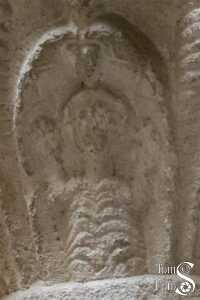Zadar is a small city on the coast of Croatia. We docked right next to old town (as with most towns in this area the “old town” is the original part surrounded by ramparts or walls with city gates for entry). This made visiting the old part of Zadar really easy. But, before doing that, one has to notice the big solar display and hear the sea organ that also sits next to old town. (See the first photo.)
The homage to the Sun is a large, round display consisting of solar cells that gathers energy from the Sun during the day and then releases that energy at night through a pretty color light display within the circle. The display consists of the large circle you can see with smaller displays radiating out along the walkway by the sea. Each of the smaller circles only produces a single color of light when lit and they all represent the planets. That part of the display is not to scale; if it were then Pluto would be some 28 miles or so away. 🙂
The sea organ is a fascinating piece of art. If you look at the photo below you will see what looks like a piano keyboard. That’s the visual part of the artwork. The audio part is in the steps you see above the solar circle. These steps lead into the ocean and the steps are constructed with sound chambers inside so that when waves push against the steps air is pushed through the sound chambers and “music” is made as each sound chamber is tuned to a different frequency. The more waves, the more and louder the sound. At times I could hear it even through the cabin’s sliding glass door. You would think the sound could be harsh but it’s really quite pleasant though I could see it becoming bothersome if one had to listen to it for long periods as there is no rhythm; it’s just notes.
The excursion here was a walking tour of the old town. The construction is similar to most such towns along southern Europe that we have visited; narrow walkways with occasional steps that serve as the “streets” in the town. In this case it was interesting to note the width of the streets as the guide showed us the old and new demarcation points. This was really made clear at the cathedral (see photo 2). After a fire the main church in the city was rebuilt. As you can see in the photo, the bell tower actually is set back about 14 feet. This was done to make the church a bit larger and it now is wider and longer than it originally was.
We saw the walls and one place where samples of all three of the walls that were built to surround the city were evident. Shops and apartments were also seen. But, one place in particular was quite interesting.
While digging for new construction they happened upon a chamber that turned out to be a small church. This church was special in that it was the last place where prisoners were put before punishment would be given the next morning; the prisoners were locked into this small space to think about what they did and what was to come be it punishment or death. Part of the carving on one of the columns in this church has a figure of a person. This carving is thought to be the very first carving of a person put onto a column in a church. Column art up to that time had been of inanimate objects. You can see this figure in the final photo.
After the walking tour of the city we were treated to wine and cheese tasting. The wine was based on sugar from cherries. I enjoyed it but did not want to stock my small refrigerator in the cabin with lots of different bottles and so did not buy any. Have to drink the koum-quat first.
We did our sail-away just about sunset so we did get to see a little of the solar art light show. Quite interesting. Our guide for the tour said that the various new art cost about 1.2 million euros and that when the artist comes to town the mayor locks his door. Apparently the artist is persuasive. 🙂
Venice next.


